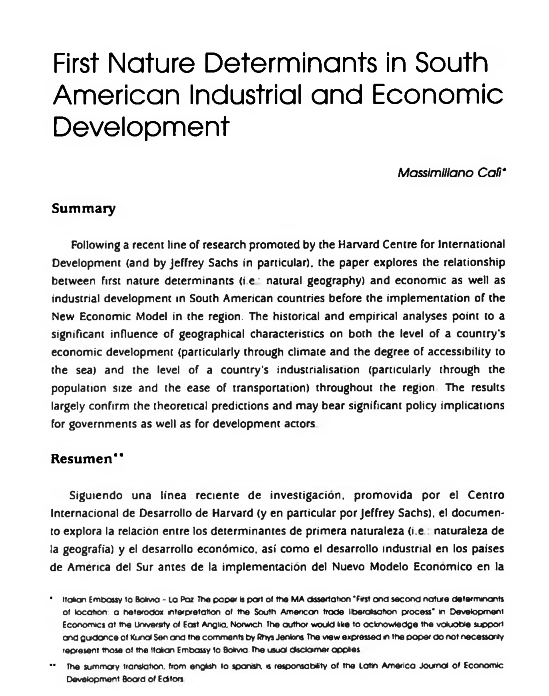First Nature Determinants in South American Industrial and Economic Development
DOI:
https://doi.org/10.35319/lajed.20043316Keywords:
New economic model, Industrial development, Economic DevelopmentAbstract
Following a recent line of research promoted by the Harvard Centre for International Development (and by Jeffrey Sachs in particular), the paper explores the relationship between first nature determinants (i.e.: natural geography) and economic as well as industrial development in South American countries before the implementation of the New Economic Model in the region. The historical and empirical analyses point to a significant influence of geographical characteristics on both the level of a country's economic development (particularly through climate and the degree of accessibility to the sea) and the level of a country's industrialisation (particularly through the population size and the ease of transportation) throughout the region. The results largely confirm the theoretical predictions and may bear significant policy implications for governments as well as for development actors.
Downloads
References
Acemoglu, D., S. Johnson and J. A. Robinson, 2002. "Reversal of fortune: geography and institution in the making of the modern world income distribution". Quarterly Journal of Economics. 117, 1231- 94.
Alcorta, M. and W. Peres, 1995 "Investment in innovation and technological adaptability in Latin America and the Caribbean". The United Nations University Intech. Discussion paper N° 9509.
Bakewell, P. 1984. "Mining in colonial Spanish America" In: Bethell L., ed. Cambridgehistory of Latin America. Vol. II 105-151. Cambridge Cambridge University Press.
CEPAL, 2001. Una década de luces y sombras. América Latina y el Caribe en los años noventa. Santiago de Chile: Alfaomega.
Diamond, J. 1997. Guns, germs, and steel: the fates of human societies. New York: W. W. Norton.
Dickenson, J. 1996. "The rise of industry in a world periphery". In: Preston. D., ed. Latin American development. Harlow Longman.
Easterly, W. and R. Levine. 2002. "Tropics, germs and crops how endowments influence economic development". NBER. Working Paper N° 9106.
Gallup, J. L. 1998. "Agricultural productivity and geography" Mimeo. Harvard Institute for International Development.
Gallup J. L., J. D. Sachs and A. D. Mellinger. 1998. “Geography and economic development" NBER. Working Paper N° 6849.
Hirschmann, A. 1958. The strategy of economic development. New Haven, CT: Yale University Press.
Krugman, 1998. "The role of geography in development". Paper prepared for the Annual World Bank Conference on Development Economics. Washington DC.
Landes, D. 1998. The wealth and poverty o f nations. New York: W .W. Norton.
Larrain, F. B., J. D. Sachs and A. M. Warner. 1999. "A structural analysis of Chile’s long term growth history, prospects and policy implications”. Document prepared for the Government of Chile.
Montesquieu, C. L., 1750. The Spirit o f Laws (English version: New York: Cambridge University Press, 1989).
Moreira, M. M. and P. G. Correa. 1998. "A first look at the impacts of trade liberalization on Brazilian manufacturing industry" World Development. 26 (10) 1859-74.
Newson, L. A. 1996. "The Latin American colonial experience". In: Preston, D., ed. Latin American development. Harlow: Longman.
Ottaviano, GIP and J-F. Thisse. 2004. "New economic geography: what about the N?" Mimeo
Radelet, S. C. and J. D. Sachs. 1998. "Shipping costs, manufactured exports, and economic growth". Mimeo. Harvard Institute for International Development.
Rodrik D., A. Subramanian and F. Trebbi. 2002. "Institutions rule: the primacy of institutions over geography and integration in economic development". NBER. Working Paper N° 9.305.
Sachs J., 2003. “Institutions don't rule: direct effects of geography on per cápitaincome”. NBER. Working Paper N° 9490.
Stallings, B. and W. Peres. 2000. Crecimiento, empleo y equidad. Santiago de Chile: Fondo de Cultura Económica CEPAL.
Summers, R. and A. Heston. 1994. The Penn World Tables. Mark 5.6. http://www.nber.org/pwt56.html
UNDESA, 2001. World population ageing: 1950-2050. New York: United Nations.
Wood A., 2002. "Could Africa be like America?". Proceedings of the Annual World Bank Conference on Development Economics. Washington DC: World Bank.
World Bank. 2002. World Development Indicators. CD-ROM.
Zattler, J. 1996. "Trade policy in developing countries a new trade policy consensus?" Intereconomics. 31(4), 229-236.






